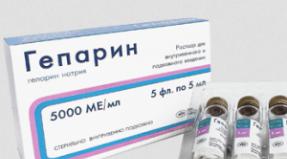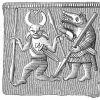Function of eosinophils in the blood. Eosinophilia: concept, causes, types, manifestations, principles of treatment. Changes in the leukocyte formula
Increased level in a nasal swab
Increased levels in sputum
Increased blood levels
1. Allergic diseases;
2. Periarteritis nodosa;
4. Idiopathic hypereosinophilic syndrome;
7. Taking medications;
8. Exposure to toxins on the body;
9. Infectious pathologies.
Increased levels in children
2. Primary form;
3. Hereditary or familial form.
Decreased blood levels
- The initial phases of the inflammatory process;
- Infectious diseases;
- Surgery and trauma;
- Severe purulent infections;
- Damage to the bone marrow with a decrease in its functions;
- Intoxication varied chemical compounds or heavy metals;
- Shock and stress conditions;
- B-12 deficiency anemia ( anemia due to lack of vitamin B12).
Both with a decrease and an increase in the level of these cells, one cannot do without the advice of a specialist.
Eosinophils in the blood
Eosinophilic leukocytes are produced in the bone marrow from a single progenitor cell. The production of this population is accelerated by the release of interleukins IL4, IL5 by T-lymphocytes.
Mature eosinophils are stained with aniline dyes (eosin), for which they got their name. The size of the mature cell form is 12-17 microns.
Life cycle
- the formation of the population occurs in the bone marrow within 34 hours;
- mature forms enter the bloodstream, where it is located for about 2 - 10 hours;
- then they migrate to the submucosal spaces - the skin, intestinal mucosa, respiratory tract, oral cavity, paranasal sinuses;
- function in tissues for 8 - 10 days.
In increased quantities, eosinophils are concentrated in the skin tissues, mucous membranes, where they are contained 100 times more than in the blood. They are found in moderate quantities in the tissues of the spleen, mammary glands, thymus, lymph nodes, uterus.
The total blood flow of the circulating blood contains no more than 1% of all human eosinophilic leukocytes.
Structural features
Eosinophil carries receptors (antigens) on its surface that are involved in immune processes. The cellular cytoplasm contains granules filled with enzymes, which, if necessary, are delivered to the site of inflammation and released into the extracellular space.
Surface antigens (AG) of eosinophilic leukocyte are able to interact with immunoglobulins IgG, IgE, components of the blood complement system C3, C4.
The rapid increase in the concentration of eosinophils in the focus of inflammation is explained by their ability to:
- to phagocytosis - the property of "devouring" small particles of destroyed cell walls of microorganisms;
- to chemotaxis - directed movement into the inflammation focus under the action of eotaxin protein, monocyte chemotaxis proteins, lymphocyte chemotaxis protein.
Under the influence of chemotaxis proteins, eosinophils can accumulate in the inflammatory focus in huge quantities, as, for example, in allergies. Elevated eosinophils show that pathogenic microorganisms, antigenic complexes, foreign toxic proteins are present in the blood.
Eosinophils are responsible for the reactivity of the immune system, phagocytose antigen-antibody immune complexes formed during immune reactions in the blood, which serves as a way to regulate inflammation in the lesion focus.
Due to surface receptors and active compounds contained in cytoplasmic granules, as well as the ability to phagocytosis and chemotaxis, eosinophil:
- is a factor of local immunity of the mucous membranes - it does not allow the penetration of foreign antigens into the general bloodstream, surrounds and destroys them in the submucosal spaces;
- enhances the immune allergic response of an immediate type, which is manifested by Quincke's edema, anaphylaxis;
- participates in allergic reaction delayed type - increased rates accompany bronchial asthma, hay rhinitis, drug intolerance, atopic dermatitis;
- controls the work of basophils and mast cells, neutralizes the histamine released by them;
- participates in autoimmune processes, which manifests itself, for example, cold urticaria;
- kills helminths and their larvae.
Norm, deviations from the norm
The rate of eosinophils in the blood in adults is 0.02 - 0.44 * 10 9 / l. The relative amount of eosinophils in the leukocyte blood count is normal 0.5% - 5%.
A condition where eosinophils are more than 5% elevated is called eosinophilia. If eosinophils in the blood of an adult are increased, reaching values greater than 6 - 8%, this indicates the possibility of infection, rheumatological disorders, and autoimmune processes.
When eosinophils in an adult are increased by more than 15 - 20% in a blood test, this condition is called hypereosinophilia, which is accompanied by a massive accumulation (infiltration) of eosinophilic leukocytes in the focus of inflammation. The tissues of the target organ, in which inflammation has occurred, are, as it were, impregnated with eosinophils.
The reason for the increased eosinophils in adults with hypereosinophilia or hypereosinophilic syndrome (HES) is a change in the ratio of lymphocytes in the blood. The content of B-lymphocytes decreases, and the number of T-lymphocytes in these conditions increases, which stimulates the production of eosinophilic cells in the bone marrow.
HPP includes diseases characterized by increased rates of eosinophils - eosinophilic inflammation of the lungs, heart (endocarditis), neurological disorders, leukemia.
Eosinopenia is a condition when the number of eosinophilic granulocytes is less than 0.5%, or in absolute terms - less than 0.02 * 10 9 / l. For more information about the normal values of eosinophils in the blood in adults and children, read the article "Norms of eosinophils".
When eosinophils are elevated
The penetration of an infection, a foreign protein (antigen) into the body triggers the activation of eosinophilic leukocytes. This stimulating effect is the reason for the massive migration of this population to the affected tissues.
An increase in the concentration of eosinophils in the blood is achieved due to the acceleration of the maturation time of the cells of this population. The reasons for the increase in indicators in general analysis blood tests for eosinophils may be:
- allergies of immediate and delayed type;
- infection with worms - roundworms, echinococci, fascils, opisthorchomas, trichinella;
- infectious respiratory, intestinal diseases caused by viruses, bacteria, fungi;
- collagenoses - periarteritis nodosa, thrombovasculitis, Behcet's disease, dermatomyositis, scleroderma, lupus, fasciitis;
- rheumatological diseases - arthrosis, gout, arthropathy;
- scarlet fever;
- lymph node tuberculosis;
- esonophilic gastroenteritis, pneumonia, myalgia;
- chorea;
- Churg-Strauss syndrome;
- ulcerative colitis;
- adrenal insufficiency;
- oncology - eosinophilic lymphogranulomatosis, myeloid leukemia, sarcidosis, erythremia, cancer of the liver, uterus, cervix, ovary.
When a woman has elevated eosinophils in her blood during pregnancy, this means that she is developing an allergic reaction. Allergies can occur both to food and to the invasion of viruses or bacteria with flu or acute respiratory infections, or infection with worms.
Allergy symptoms are difficult to recognize if this condition appears in a woman for the first time, and it is masked by the features of pregnancy - toxicosis, nausea, skin rashes.
Changes in the leukocyte formula
An increase in the concentration of eosinophils is accompanied by changes in the content of other cells immune system... Both eosinophils and lymphocytes, elevated at the same time, are found in the blood when infected with the Epstein-Barr virus, helminths. A similar picture is observed with allergic dermatoses, treatment with antibiotics and sulfonamides (biseptol), scarlet fever.
Above the norm in the analysis of blood eosinophils and monocytes with mononucleosis, viral, fungal infections. Increased test rates for syphilis, tuberculosis.
Leukocytosis, increased eosinophils, the appearance of atypical lymphocytes in the blood is observed in DRESS syndrome - a systemic allergic reaction to medicinal product... It can take up to 2 months between taking the drug and the appearance of the first signs of an extended allergic reaction of the body to the drug.
The symptoms of DRESS syndrome are:
- enlarged lymph nodes;
- skin rashes;
- temperature rise;
- prostration.
If the drug is not canceled, there may be lesions with granulocytes accumulated in the tissues of such organs as the lungs, liver, kidneys, and the digestive tract.
Complications with elevated eosinophils
The action of factors that stimulate the formation of eosinophils can cause an exaggerated response, a kind of "inflammatory" blood reaction - hypereosinophilia.
The number of eosinophils in hypereosinophilia can be increased hundreds of times compared to the norm. Leukocytes in a similar state are increased to 50 * 10 9 / l, while 60 - 90% of the total number of white blood cells may be eosinophils.
When proteolytic enzymes are released from granules, not only pathogenic microorganisms are damaged, but also their own cells. First of all, cells of the inner lining of blood vessels (endothelium) of the entire circulatory system are affected.
Lesions in Severe Eosinophilia
The action of enzymes that enter the bloodstream from granulocytes provokes inflammation, which causes tissue cells in the lesion to die. With a massive accumulation of granulocytes, the damage is so significant that it disrupts the work of the target organ.
This means that if eosinophils in the blood are elevated for a long time, and their indicators are much higher than normal, then such vital organs as, for example, the heart, suffer. Signs of damage to the endocardium and myocardium are found very often in conditions associated with prolonged elevated levels of eosinophilic leukocytes in the blood.
Such a condition, when eosinophils are increased in the blood test, in children it speaks of helminthic invasion, allergies, in adults it means that inflammation develops in the joints, skin, and the respiratory system.
With congestion increased number granulocytes in the lung tissue develop eosinophilic pneumonia. This condition has a high risk of pulmonary edema.
For children, the typical causes of increased test scores are atopic dermatitis and bronchial asthma. The increased content of granulocytes in tissues and blood in both adults and children has a damaging effect on the central nervous system.
According to the level of increase in eosinophilic granulocytes in the blood, it is not always possible to correctly assess the degree of tissue damage. In tissues, the number of eosinophilic granulocytes can be significantly higher than a blood test shows.
What do eosinophils mean in a blood test - norm and deviations
Eosinophil synthesis site - red Bone marrow... The full ripening process lasts 3-4 days. Then, normally, eosinophils enter the bloodstream and circulate there for 3 to 8 hours. Then they penetrate into tissues and interstitial spaces - mainly into the lungs, skin and gastrointestinal tract, where they function for 6-8 days.
Eosinophils in the circulating blood are represented by cells with sizes from 12 to 20 microns. Dimensions in dry blood smear - microns. The cell nucleus, located in the center, consists of 2 segments and is surrounded by numerous granules, the presence of which assigns eosinophils to the first subgroup of leukocytes - granulocytes.
Eosinophilic granularity - granules of eosinophils, unlike granules of other granulocyte leukocytes (neutrophils and basophils), during a general blood test, are stained with basic dyes in an intense orange-red color and resemble red caviar. Eosinophil grains are mainly represented by two types:
- lysosomes containing peroxidase;
- nonspecific acid phosphatase granules.
Eosinophils in the blood of men, women and children, namely, a change in their level of content, cannot accurately indicate the presence of a specific disease, but an assessment of the dynamics of changes in their number during the course of an already established inflammation has a significant prognostic meaning.
Eosinophil functions
Eosinophils, although they are microphages - phagocytes capable of absorbing and digesting small foreign particles - but their main task is not this.
The second, no less important, functional responsibility of eosinophils is the absorption and binding of histamine, serotonin and other mediators of allergies and inflammations. At the same time, they play both a pro-allergic and antiallergic role, therefore eosinophils literally save allergy sufferers from anaphylactic shock, since they regulate and reduce the strength of the allergic response.
Eosinophils also play a great role in the formation of processes necessary for wound healing. They modify and transport the antigen to the precursor of the body-forming cell, and then destroy the formed antigen-antibody complexes.
Among other functions, one can highlight the participation of eosinophils in the process of lactation in women in postpartum period... Their indicators at this time in the blood test become slightly higher than normal. And although such a function is classified as non-immune, such a statement is rather controversial, because breast milk mother becomes one of the important factors of the child's immune defense.
Eosinophils in a blood test
The number of eosinophils in the blood plasma is calculated during a general blood test when drawing up a leukocyte formula. The level of eosinophilic cells, like other types of leukocytes, can occur either in relative (EO%) or in absolute (EO #) values.
At the beginning of the analysis, all leukocyte cells are counted - WBC (international designation in the analysis form). If the value of this indicator is lower than 4.0 * 10 9 / l, then eosinophils will be counted not in relative, but in absolute numbers.
The rate of eosinophils in the blood does not depend on gender, but depends on age:
Eosinophils above or below normal
If the level of eosinophilic cells exceeds normal values, then this condition is called eosinophilia, and if it is lower, it is called eosinopenia. They are not diagnoses, but represent clinical symptom blood test.
Eosinophilia
Conditions when eosinophils in the blood are increased are subdivided into several degrees, which characterize the severity of the pathology:
- Mild eosinophilia - an increase in EO% in the range from 5 to 10%.
- Moderate degree - 10-15%.
- The expressed degree of eosinophilia is more than 15%.
These values are questioned, since many modern hematologists insist that moderate eosinophilia in both children and adults is observed with EO% = 10-20%.
The second place among the reasons that cause a condition when eosinophilic leukocytes in the blood are increased is allergic diseases: bronchial asthma, hay fever, serum sickness, urticaria in a child.
Eosinophilia is the main component for clarifying the diagnosis of bronchial asthma, and differentiating it from cardiac asthma, as well as from chronic bronchitis with attacks of suffocation.
Also, if eosinophils in the blood are elevated, then this means the possible presence of the following diseases or effects of other causes:
- drug allergy, especially to antibiotics, as well as overdose of aspirin and iodine-containing drugs;
- acute lack of magnesium;
- extensive burns and frostbite;
- dermatitis and eczema;
- chronic gastrointestinal diseases, including gastritis and ulcers;
- food allergies, in a child it may be a reaction to cow's milk;
- in women - sometimes, during the first phase menstrual cycle;
- oncological pathologies with extensive necrosis;
- bone marrow cancer, leukemia, or lymphoma.
If a high rate of eosinophils persists for a long time, then this can lead to tissue damage and their partial destruction.
Leffler's endocarditis, which is not diagnosed in time, can lead to such consequences, which poses a great danger to health, but is dangerous mainly for children and young men, immigrants from Asia, Africa and South America.
Eosinopenia
The reasons for the decreased eosinophilic leukocytes can be:
- an acute inflammatory process of any etiology, while other leukocytes - neutrophils and lymphocytes, will be much higher than normal;
- excessive physical activity;
- stressful conditions and painful shock, including childbirth;
- chronic lack of sleep;
- clinical symptom of the first days after a heart attack;
- acute appendicitis or peritonitis;
- Cushing's syndrome;
- long-term use of corticosteroids;
- Down syndrome.
Therapeutic therapy of both eosinophilia and eosinopenia can be carried out only with the exact establishment of their root causes and diagnosis. With special attention to the correction of such conditions, it is necessary to approach during pregnancy, because in this case we are talking about maintaining the health of two people.
Eosinophils: functions, norm and causes of deviation from the norm
The human body is an individual and unique structure, where each of its separate parts is responsible for performing a specific function. Eosinophils, which belong to a variety of leukocytes, play an important role in its normal work.
The functions of eosinophils in the human body are quite diverse and, above all, they have a disinfecting effect on foreign proteins, and also take an active part in allergic reactions.
Functions of eosinophils in the body
Description and role of eosinophils in the blood
Eosinophils are a type of white blood cell that control the binding of a foreign protein in the blood. These blood cells are completely transparent and contain enzymes that have the ability to dissolve the absorbed protein.
The main site of eosinophil formation is predominantly the bone marrow. In this part of the human body, they stay for 7-8 days while their maturation process lasts, and then they move into the blood vessels. Their progress in blood vessels lasts for several hours and upon reaching certain tissues, such cells of the immune system remain in them for several weeks.
In the human body, eosinophilic leukocytes perform different functions and some of them are similar to those inherent in other white blood cells.
They are actively involved in various inflammatory processes and especially those that are closely intertwined with allergic reactions. In addition, eosinophils play a role in the formation of certain organs.
Eosinophilic leukocytes can perform not only positive, but also negative functions. Most often, they perform a protective function and protect the body from the penetration of dangerous microorganisms into it. Sometimes, with certain diseases, eosinophils can cause various pathological changes.
The rate of eosinophils
Decoding and indicator rate
Medical practice shows that the presence in the human body of 1-6% of eosinophils from the total number of leukocytes is considered the norm.
The main places of their concentration in the body are:
Have healthy person eosinophilic leukocytes should be absent in the following organs:
In the event that, after diagnostic studies, their presence in these organs is revealed, then this may indicate the development of pathology.
More information about the blood test for eosinophils can be found in the video.
The rate of eosinophils can change throughout the day and depends on the characteristics of the adrenal glands. In the morning and evening, the level of these immune cells is lower than at night.
To identify the content of eosinophilic leukocytes in the human body, a specialist performs a general blood test.
If necessary, the patient's sputum or mucus secreted from the nasal cavity can be examined. V childhood the norm is the level of eosinophils in the range of 0.5-7%. In adult patients, the content of such immune cells in the body should vary from 0.5 to 5% of general level leukocytes.
Increased content of eosinophils
Eosinophils are elevated: causes and possible diseases
In the event that it is diagnosed increased content eosinophilic leukocytes, experts say about the development of such a pathological state of the human body as eosinophilia.
Several degrees of pathology are revealed:
An increase in the level of eosinophilic leukocytes can occur for the following reasons:
- the development of an allergic reaction and this is considered one of the main reasons for an increase in the content of immune cells
- the appearance of a reaction to the reception pharmacological preparations that are used in the treatment of the patient
- insufficient content of magnesium in the patient's body
- reproduction of helminthic and protozoal invasions
- progression of pathologies in the body gastrointestinal tract chronic
- development various diseases skin
- the appearance in the body of malignant neoplasms
In some cases, an increased content of eosinophils in a person's blood may indicate a positive trend. With the progression of infectious diseases high level such immune cells are considered a positive sign of recovery.
Low eosinophil count
Eosinophils are lowered - possible diseases
In the event that the patient is diagnosed with low level eosinophilic leukocytes in the blood, it is considered one of the symptoms of depletion.
Most often, the development of such a pathological condition as eosinopenia is observed under the influence of stresses of a different nature:
- the initial stage of development of infectious diseases
- the patient's condition after surgery
- skin burns
- injuries of various kinds
- blood poisoning
If the level of immune cells is too low, we can talk about the development in the body of such dangerous diseases, how:
A slight decrease in eosinophils is a common condition for people with Down syndrome and those patients who suffer from constant lack of sleep.
Decrease or increase of eosinophils in the human body requires specialist advice.
The indicator of eosinophilic leukocytes in the blood must be kept normal, since they can bring not only benefits to the body, but also harm.
Have you noticed a mistake? Select it and press Ctrl + Enter to tell us.
/ Ref. material / BLOOD / LEUKOCYTES / 04.EOSINOPHILES
Eosinophils are larger than neutrophils. Their amount in the peripheral blood ranges from 1-5%,) I-5-70 in 1 μl). If the content of their number is more than 0.5 -109 / l, this is eosinophilia.
A characteristic feature of eosinophils is the presence of specific oxyphilic granules containing a large basic protein rich in arginine. This protein is cytotoxic, damages some helminth larvae, and neutralizes heparin. In addition, there are cationic proteins that affect the course of inflammatory reactions and plasma
coagulation link of hemostasis. These proteins are believed to destroy the endothelium and contribute to the development of certain types of cardiac and vascular pathologies through the activation of the kallikrein-kinin system. There is also eosinophilic protein-X (identical to the neurotoxin produced by eosinophils).
Unlike neutrophils, eosinophils have a high oxidative metabolism and they produce more hydrogen peroxide. Aryl sulfatase of eosinophils inhibits anaphylactoid substances, thereby suppressing immediate hypersensitivity reactions. Prostag-landins, secreted by eosinophils, inhibit the degranulation of mast cells. With the participation of enzymes (histaminase, arylsulfatase, phospholipase) and a large basic protein, eosinophils inactivate histamine and heparin. They synthesize plasminogen, therefore, when they are destroyed, fibrinolysis is disrupted.
Eosinophils are involved in the regulation of hematopoiesis, in particular, granulopoiesis. It is believed that they, through prostaglandins E, inhibit the formation of granulocyte-microphage colonies. This explains the frequent occurrence of neutropenia in eosinophilia.
Eosinophils, like neutrophils, have the ability to amoeboid movement, chemotaxis. Prostaglandins type D2 and E2 stimulate the membrane of eosinophils, causing their locomotor activity. The chemotactic activity of these leukocytes in allergic reactions is caused by eosinophilic chemotactic factors of anaphylaxis, lymphokines, monokines, immune complexes, chemotactic factor of eosinophils (secreted by segmented neutrophils, basophils and mast cells), histamine, etc.
Eosinophils have phagocytic activity, but less than neutrophils. They phagocytose bacteria, fungi, mycoplasma, immune complexes, and tissue decay products.
The main functions of eosinophils
1. Reduction of an immediate hypersensitivity allergic reaction. In this reaction, the receptors of basophils and mast cells bind to antibodies-JgE, which causes degranulation of these cells with the release of biologically active substances, including histamine and eosinophilic chemotactic factor ^, this is a signal to move to the focus of allergization of blood corpuscles, including and eosinophils. The latter inactivate histamine. And this is done in two ways.
The first method of inactivation of histamine occurs due to the presence of histamine receptors binding it on eosinophils and due to phagocytosis of mast cell granules, histamine of which destroys eosinophil histaminase.
The second way to inactivate histamine is to inhibit its release from basophils and mast cells. It was found that eosinophils contain a factor that inhibits the release of histamine (probably prostaglandins E] and E2). This factor is released from eosinophils during their destruction and upon contact with antibodies-JgE. Under the influence of this agent, adenylate cyclase is activated in basophils and mast cells, which leads to an increase in the synthesis of cAMP. An increase in the cAMP content inhibits the release of not only histamine, but also other biologically active substances from basophils and mast cells. In addition, eosinophil arylsulfatase B inactivates the slow-reacting substance of anaphylaxis; large basic protein - heparin; phospholipase D is a lytic factor of platelets that prevents the release of serotonin from them. The eosinophilic factor stimulating fibroblasts promotes fibrosis of the local focus, its limitation and, in combination with histamine inactivation, a significant decrease in the severity of local reactions in tissues during an allergic reaction and inflammation
2. Antihelminthic immunity, or cytotoxic effect. This effect is mediated by JgG antibodies and complement. The latter can be activated both by antihelminthic JgG antibodies and by the outer covers of helminths, which are covered with activated C3 and JgG antibodies. The killer effect of eosinophils is carried out as follows. During the invasion of helminth larvae, their antigens stimulate the production of JgE, which sensitize basophils and mast cells in this place. As a result, the latter degranulate with the release of many substances, including the chemotactic factor of eosinophils, histamine, etc. Eosinophils are attracted to the site of invasion, they are activated and their receptors come into contact with antibodies-JgG and activated C3 on the surface of the larvae. This leads to the degranulation of eosinophils with the deposition of a large basic protein and peroxidase on the surface of the larvae, which causes their damage, lysis and death.
(3. Prevention of the penetration of antigen into the vascular / tissue) This function is due to the fact that eosinophils are tropic to the surface tissues: leaving the capillaries, they meet antigens on the way and bind them. Thus, they prevent the entry of antigens into the vessels.
Eosinophil kinetics. They mature in the bone marrow for about 9 days. After that, they enter the bloodstream, while 50% of them settle in the tissues within 1 hour. The half-life of eosinophils in the blood is 3-8 Cx From the blood, eosinophils migrate to tissues, more often to the mucous membrane of the respiratory tract, gastrointestinal tract, genitourinary system, skin, etc. Usually, eosinophils do not return to the blood from tissues, only occasionally their recirculation is possible ... They live in tissues for several days and then die. The ratio of the number of eosinophils in blood and tissue is 1: 300-1: 500.
Regulation of eosinophil production. The main humoral stimulants of eosinophilopoiesis are eosinophilopoietins. The eosinophilostimulating factor (one of the lymphokines) secreted by lymphocytes also enhances the production of these cells. Eosinophilia is noted with allergies, with helminthic invasion, with antibacterial therapy... This increase in the number of eosinophils is caused by the increased release of histamine into the blood and tissues.
Eosinopenia is caused by ACTH, glucocorticoids and adrenaline. So, the mechanism of action of the latter is that they:
firstly, they inhibit division and destroy lymphocytes, which reduces the release of eosinophil-stimulating factor;
secondly, they increase the content of eosinophils in tissues;
thirdly, they detain them in the bone marrow;
fourthly, they enhance the phagocytic activity of the MFS elements in
Hence, the development of eosinopenia under stress is understandable: activation of the sympathoadrenal system and glucocorticoid function of the adrenal glands. This is associated with the circadian rhythm of eosinophils (maximum - in the morning, minimum - in the evening).
Eosinopenia is observed with anaphylactic shock, in the acute phase of many infectious processes. In shock, a decrease in the number of eosinophils in the blood is due to their rapid flow from the blood into the tissues (tissue eosinophilia).
Eosinophils: what are they for, norms in the blood, causes of deviations
Forming in the bone marrow, eosinophils (EO) go through the same stages as neutrophils. The tissue pool of eosinophils, represented by cells concentrated in tissues, tissue fluids, intestinal submucosa, airways, and skin, significantly exceeds their content in peripheral blood. Cells do not live long, only a few hours; they die into tissues, where they are divided into separate fragments (apoptosis) and are absorbed by macrophages.
Main tasks and functions
Despite the short life of eosinophils, they are classified as very significant inhabitants of the blood, endowed with certain abilities to solve important problems:
However, all this is complicated and incomprehensible, so let's try to consider the main role of eosinophils using a simple example.
A simple example
For example, some agent enters the organism, which is alien for the latter.
- Eosinophils become "alert": they migrate to the scene, lengthening their life span, increase the production of biologically active substances, and form adhesion molecules on their surfaces, through which cells cling to the epithelium. We can assume that the acquaintance took place, and the body responded with its own reaction: cough, lacrimation, rash, and so on.
- All the more, a return visit from a foreign agent does not go smoothly. The allergen meets on its way the immunoglobulin E developed after the first time, which quickly recognizes the enemy, combines with him and forms with the AT-AG complex. Eosinophils, capturing these complexes (phagocytosis), secrete mediators (the main basic protein, leukotrienes, peroxidase, neurotoxin). The influence of these mediators is also well known to people who have a high response to stimuli, for example, bronchospasm of asthmatic origin (contraction of the bronchi, suffocation, mucus formation, etc.).
This behavior of eosinophils can explain the increase in their level when a person overcomes the infection (many people themselves noticed that at the end of the inflammatory process, the amount of E. in the analysis is increased), because they must collect all the reaction products between the pathogen and antibodies that the body has developed for fight.
In this situation, the level of E. above the norm can be a very encouraging indicator: the disease is receding.
There is safety in numbers
It should be noted that eosinophils are not the only cells involved in responding. At all stages, they are actively helped by a small but important group of granulocytes - basophils and mast cells. Basophils formed in the bone marrow do not create a reserve, but go directly to the periphery. Their blood contains nothing at all - 0 - 1%. Their tissue form - mast cells or mast cells, live in large quantities in the skin, connective tissue and serous membranes. Basophils phagocytose poorly, live not long, but productively.
Granules of these cells contain histamine, serotonin, heparin, proteolytic enzymes, peroxidase and other biologically active substances, which, if necessary, will be released outside, for example, in case of an allergic reaction. Basophils, having on their surfaces a large number of receptors (for binding IgE, complement, cytokines) and “sensing something was wrong,” quickly migrate to the site of penetration of a foreign antigen, therefore they are almost always present in the places of the main activity of eosinophils.
Rate and deviations
Normally, eosinophils in the blood fluctuate in the range of 1 - 5% or in absolute values, their content ranges from 0.02 to 0.3 x 10 9 / l (in adults), and their relative amount in the leukocyte formula does not depend on age, but depends on the level in absolute numbers.
It is believed that eosinophils are increased in an adult if the number of cells is more than 0.4 x 10 9 / l, while in a child an indicator exceeding the limit of 0.7 x 10 9 / l is taken for eosinophilia. And these cells are also characterized by daily fluctuations: at night the highest, during the day, on the contrary, the lowest level of eosinophils is noted.
Eosinopenia, when both in percentage and in absolute numbers, the level of cells tends to 0, is very characteristic of initial stage inflammatory process (up to the crisis). The absence of eosinophils in the blood is explained by the fact that all cells are in the zone of inflammation, however, at this time, with a favorable course of the disease, leukocytes (leukocytosis) are noticeably increased, although the opposite is true when the analysis shows leukopenia and eosinopenia are not encouraging signs.
Table: norms in children of eosinophils and other leukocytes by age
Increased eonophils (eosinophilia)
Eosinophilia(same as eosinophilia) - an increase in the level of eosinophilic leukocytes in adults is above 0.4 x 0.4 x 10 9 / l, in children - 0.7 x 10 9 / l is observed in the following pathological conditions:
- Any diseases with an allergic onset: bronchial asthma, skin lesions (eczema, psoriasis, dermatitis, lichen scaly), periarteritis nodosa, hay fever, eosinophilic vasculitis, helminthic invasion. This category should include a disease of hypersensitivity to certain drugs and other chemicals, for example, when exposed to antibiotics (penicillin, streptomycin). At the same time, they do not have to get inside, sometimes it is enough just to come into contact with them, so that the skin of the hands begins to itch and crack, which is often observed in nurses working in hospitals.
- Reaction to the introduction of antibacterial drugs.
- Infectious and inflammatory process (stage of recovery).
In other frequent cases, other diseases become the cause of an increase in eosinophils:
Considering elevated level eosinophils in the blood, it is worthwhile to dwell on such a phenomenon as hypereosinophilia ( hypereosinophilic syndrome) and its complications, which largely affect the heart muscle, causing the necrosis of its cells.
Hypereosinophilic syndrome
The reasons for the increase in eosinophils up to 75% have not been thoroughly studied, however, it has been noticed that helminthic invasion, periarteritis nodosa, cancers of various localizations, eosinophilic form of leukemia, bronchial asthma and drug disease play an important role in the development of such a condition. Well, there are plenty of reasons for that ...
Eosinophilia, which remains at high numbers for several months, makes one suspect a process that destroys the tissues of the parenchymal organs (heart, liver, kidneys, spleen), and in other cases even affects the central nervous system.
dermatitis with hypereosinophilic syndrome
At hypereosinophilic syndrome(HES) not only an increase in the number of eosinophils is observed, but also their morphological changes. Altered cells can cause irreparable damage to the heart (Leffler's disease). They seep into the muscle (myocardium) and inner (endocardium) membranes and damage the heart cells with protein released from the eosinophil granules. As a result of such events (necrosis) in the heart, conditions are created for increased thrombus formation, damage to the ventricles (one or both), the valve and subvalvular apparatus with the development relative mitral and / or tricuspid valve insufficiency.
There are few eosinophils
A condition when eosinophils are reduced (less than 0.05 x 10 9 / l) is called eosinopenia... This number of cells, first of all, indicates that the body does not cope well with the effects of various foreign factors inhabiting the external and internal environment.
The reason for the decrease in the body's resistance, which is reflected in the blood test, is often various pathologies:
- Separate acute intestinal infections(dysentery, typhoid fever);
- Acute appendicitis;
- Sepsis;
- Injuries, burns, surgery;
- The first day of myocardial infarction development;
- Acute inflammation (maybe zero, and then, on the contrary, above the norm - a sign of recovery).
It should be noted that decreased eosinophils are in cases far from those listed, and even from pathology in general: psychoemotional overstrain, excessive exercise stress, the influence of adrenal hormones.
It may only seem at first glance that this population of leukocytes is invisible (are they there or not?), Because in the blood test their level large size they do not differ. But eosinophils perform important functions, and no special training is needed to determine them: a general blood test from a finger, which people call expanded (leukocyte formula), is a significant diagnostic indicator that can tell not only about the presence of a disease, but also about the stage of the pathological process ...
What do eosinophils in the blood talk about?
Leukocytes are constantly on guard of our body. Eosinophils in the blood are a type of white blood cell. These are rounded polymorphic granule-containing cells, the diameter of which is µm, the nucleus consists of two or three lobules.
Distinctive characteristics
The main distinguishing feature and characteristics of eosinophils is the presence of eosinophilic granules in the cytoplasm. Eosinophil granules vary in size. It is they who give the red color to this cell in the native smear. Large eosinophilic granules, 1.5 μm in diameter, contain crystalloid (basic blood protein, heparin neutralizers, and inflammatory mediators). Small granules are primary, azurophilic, the diameter is 0.4 μm, they contain acid phosphatase and arylsulfatase B.
There are fewer eosinophils than neutrophils in the blood. Maturation and differentiation of these cells occurs in the bone marrow. After maturation, they enter the bloodstream, where they circulate for up to 12 hours, then migrate to the lung tissue, gastrointestinal tract, and skin. It can stay in tissues for up to 14 days. Senescent eosinophils are removed from the body through the intestinal epithelium.
Functions
Eosinophil functions
The rate of eosinophils is a relative concept. The number of eosinophils in the blood differs in children, men, women. Day and night, the total number of these cells in the blood is different. In women, in different phases of the menstrual cycle, the absolute values of the content of eosinophils may change. Also, individual variability cannot be ignored.
But the percentage of eosinophils, which is calculated for the leukocyte formula, is of great diagnostic value. The level of eosinophils in the blood should normally be 1-5%. In absolute numbers, the content of eosinophils can reach 0.02-0.45 X 10 ^ 9 / l.
In children
The norms of indicators of eosinophils in a child are different from each other. So, for example, absolute values:
- for a child of 1 year old can vary from 0.05 to 0.7;
- for 4 years, the range is 0.02 - 0.7;
- for 10 years - 0.02-0.6. (All values are multiples of x 10 ^ 9 / L).
Rise and decline
A condition in which eosinophils in the blood are elevated is eosinophilia. If eosinophils in the blood are lowered - eosinopenia. They are not diseases in and of themselves. If the cause is cured, then the level of eosinophils in the body will also return to normal.
The causes of eosinophilia, an increase and decrease in the level of eosinophils in the blood:
With any allergic reactions, eosinophils increase in the blood
Primary and secondary eosinophilia
Primary eosinophilia is observed with blood leukemia. It is often accompanied by an increase in basophils, with the appearance of the so-called eosinophilic-basophilic association. Secondary eosinophilia is observed in the presence of some underlying disease (for example, ascariasis).
The reasons for the increase in eosinophils in the blood in children are, in general, the same as in adults.
Eosinophilia in childhood can be classified as:
- primary eosinophilia. Occurs in the disease and hematopoietic organs with lymphogranulomatosis, hairy cell leukemia;
- familial and constitutional eosinophilia can also occur in healthy children. The course of this disease is chronic. An exacerbation can be manifested, for example, by asthmatic bronchitis;
- reactive eosinophilia. It occurs most often as a result of intrauterine allergic reactions, various infections.
Eosinopenia
Eosinopenia is observed in many conditions, which can be both physiological and pathological.
Treatment
To adjust the rate and treat eosinophils, you first need to find out the reason for the changes in indicators in the general blood test. Sometimes, to clarify the diagnosis, you need to go through a number of additional functional and laboratory tests: to make an x-ray of the lungs, to pass urine and feces for analysis.
These blood cells are of great diagnostic value. A change in their number is an important signal that will make it clear to the diagnostician that a physiological or pathological failure has occurred in the body with a certain probability.
Eosinophilia serves as a marker for a wide variety of diseases and is found in the blood of patients of all ages. In children, this phenomenon can be detected even more often than in adults due to exposure to allergies, infections, helminthic invasions.
This is a type of white blood cell that gets its name from the pink cytoplasm, which is clearly visible on microscopy. Their role is to participate in allergic reactions and immune processes, they are able to neutralize foreign proteins, produce antibodies, absorb histamine and its decay products from tissues.

eosinophil and other leukocytes
Normally, there are few eosinophils in the peripheral blood - no more than 5% of the total number of leukocytes. When determining their number, it is important to know not only the percentage with other populations of the white sprout of hematopoiesis, but also the absolute number, which should not exceed 320 per milliliter of blood. In healthy people, the relative number of eosinophils is usually determined, and when it deviates from the norm, they resort to calculating the absolute indicator.
Formally, an indicator is considered to be eosinophilia - more than 0.4 x 10 9 / l of eosinophils for adults and 0.7 x 10 9 / l on average for children.
In most cases, eosinophils indicate the presence or absence of allergies and immunity. in this regard, since their direct function is to participate in the neutralization of histamine and other biologically active substances. They migrate to the focus of an allergic reaction and reduce its activity, while their number in the blood inevitably increases.
Eosinophilia is not an independent pathology, it reflects the development of other diseases, the diagnosis of which is aimed at a variety of studies. In some cases, it is rather difficult to determine the cause of eosinophilia, and if it is established that it is caused by an allergy, then the search for an allergen may not give any result.
Primary eosinophilia is a rare phenomenon that characterizes malignant tumors, in which there is an excessive production of abnormal eosinophils in the bone marrow. Such cells differ from normal cells, which increase with the secondary nature of the pathology.
The causes of eosinophilia are extremely diverse, but if it is found, and the number of cells is extremely large, then you cannot do without a thorough diagnosis. Self-treatment eosinophilia does not exist, it is determined by the disease that caused the increase in eosinophils in the blood.
It is not necessary to undergo complex studies to determine the ratio of eosinophils to other blood cells. A routine blood test, which we all take periodically, will show the norm or deviation, and if not everything is going well in the general blood test, then the doctor will prescribe a count of the exact number of cells.
Causes and forms of eosinophilia
The severity of eosinophilia is determined by the number of eosinophils in the blood. She may be:
- Easy - the number of cells does not exceed 10%;
- Moderate - up to 20%;
- Severe (high) - more than 20% of eosinophils in the peripheral blood.
If an excess of eosinophils is recorded in the blood test in relation to other populations of leukocytes, then the doctor will calculate their absolute number based on the percentage, and then it will become clear whether eosinophilia is relative or absolute. More reliable data are obtained by direct counting of eosinophils in a counting chamber, after diluting the blood with special fluids.

eosinophilia in the blood
The number of diseases accompanied by eosinophilia has several dozen nosological forms, and all of them can be combined into groups:
Video: eosinophils, their main functions
Many infections with pronounced symptoms of allergy to the pathogen and its waste products give eosinophilia in the blood test - scarlet fever, tuberculosis, syphilis. At the same time, eosinophilia at the stage of recovery, which is of a temporary nature, serves as a favorable sign of the beginning of recovery.
Allergic reactions are the second most common cause of eosinophilia. They are found more and more often due to the deterioration of the ecological situation, saturation of the surrounding space with means household chemicals, the use of a variety of medications, foods rich in allergens.

eosinophils perform their function in the “problem” focus
Eosinophil is the main "character" in the focus of an allergic reaction. It neutralizes biologically active substances responsible for vasodilation, tissue edema on the background of allergies. When an allergen enters a sensitized (sensitive) organism, eosinophils immediately migrate to the site of the deployment of the allergic response, increasing both in the blood and in the tissues.
Among the allergic conditions accompanied by eosinophilia, there are often bronchial asthma, seasonal allergies (hay fever), diathesis in children, urticaria, and allergic rhinitis. Allergies to medications - antibiotics, sulfonamides, etc., can also be classified in this group.
Skin lesions, in which the immune response is pronounced with symptoms of hypersensitization, also occur with eosinophilia. These include infection with the herpes virus, neurodermatitis, psoriasis, pemphigus, eczema, which are often accompanied by severe itching.
Autoimmune pathology characterized by the formation of antibodies to own tissues, that is, the proteins of the body begin to attack not someone else's, but their own. An active immune process begins, in which eosinophils are also involved. Moderate eosinophilia is manifested in systemic lupus erythematosus, scleroderma. Immunodeficiencies can also provoke an increase in the number of eosinophils. Among them are mainly congenital diseases (Wiskott-Aldrich syndrome, T-lymphopathy, etc.).
Taking many medications accompanied by activation of the immune system with the production of an excess of eosinophils, while an obvious allergy may be absent. These drugs include aspirin, aminophylline, beta-blockers, some vitamins and hormones, diphenhydramine and papaverine, drugs for the treatment of tuberculosis, certain antihypertensive drugs, spironolactone.
Malignant tumors may have eosinophilia as laboratory symptom(Wilms tumor, cancer metastases to the peritoneum or pleura, skin cancer and thyroid gland), others directly affect the bone marrow, in which the maturation of certain cells is disturbed - eosinophilic leukemia, myeloid leukemia, polycythemia vera, etc.
Internal organs, the defeat of which is often accompanied by an increase in eosinophils, are the liver (cirrhosis), lungs (sarcoidosis, aspergillosis, Leffler's syndrome), heart (defects), intestines (membranous enterocolitis).
In addition to these diseases, eosinophilia appears after organ transplant operations (with immune rejection of the transplant), in patients on peritoneal dialysis, with a lack of magnesium in the body, after radiation.
In children, the rates of eosinophils are somewhat different. In newborns, they should not be higher than 8%, and until the age of 5, the maximum value of eosinophils in the blood of 6% is allowed, which is due to the fact that immunity is just being formed, and the child's body is constantly faced with new and hitherto unknown potential allergens.
Table: average values of eosinophils and norms of other leukocytes in children by age

Manifestations and certain types of eosinophilia as an independent pathology
The symptoms of eosinophilia as such cannot be distinguished, because it is not an independent disease, but in some cases of the secondary nature of increased eosinophils, the symptoms and complaints of patients are very similar.

- , liver and spleen;
- - especially with intestinal damage, malaria;
- Decrease in body weight;
- Constant low-grade fever;
- Joint pain, muscle pain, weakness, loss of appetite;
- Attacks of dry cough, skin rash.
Allergic reactions manifested by itching of the skin (urticaria), blistering, edema of the neck tissues (Quincke's edema), a characteristic urticarial rash, in severe cases, collapse is possible, a sharp drop blood pressure, skin exfoliation and shock.
Digestive tract disorders with eosinophilia are accompanied by symptoms such as nausea, stool disorders in the form of diarrhea, vomiting, pain and discomfort in the abdomen, discharge of blood or pus with feces in colitis, etc. The symptomatology is not associated with an increase in eosinophils, but with a specific gastrointestinal disease. the intestinal tract, the clinic of which comes to the fore.
Signs of tumor pathology, leading to eosinophilia due to damage to the lymph nodes and bone marrow (paraproteinemia) - fever, weakness, weight loss, pain and aches in joints, muscles, enlarged liver, spleen, lymph nodes, a tendency to infectious and inflammatory diseases.
Eosinophilia is extremely rare as an independent pathology, while the lungs are considered the most frequent localization of tissue accumulation of eosinophilic leukocytes. Pulmonary eosinophilia combines eosinophilic, pneumonia, the formation of eosinophilic infiltrates.

cutaneous hemorrhages accompanied by eosinophilia
In the lungs with Leffler's syndrome, accumulations of eosinophils are formed, which resolve by themselves, leaving no consequences, so the pathology ends in full recovery. On auscultation, wheezing may be detected in the lungs. In the general analysis of blood against the background of multiple eosinophilic infiltrates in the lungs, detected by X-ray, leukocytosis and eosinophilia appear, sometimes reaching 60-70%. The X-ray picture of lung tissue damage lasts up to a month.
In countries with hot climates (India, the African continent), the so-called tropical eosinophilia occurs, in which infiltrates also appear in the lungs, the number of leukocytes and eosinophils increases in the blood. The infectious nature of the pathology is assumed. The course of tropical eosinophilia is chronic with relapses, but spontaneous healing is possible.
With pulmonary localization of eosinophilic infiltrates, these cells are found not only in peripheral blood, but also in secretions from the respiratory tract. Eosinophilia of sputum and mucus from the nasal cavity is characteristic of Leffler's syndrome, tropical eosinophilia, bronchial asthma, allergic rhinitis, hay fever.
Muscles, including the myocardium, can become another possible localization of tissue eosinophilic infiltrates. At endomyocardial fibrosis there is an overgrowth of connective tissue under the inner layer of the heart and in the myocardium, cavities decrease in volume, heart failure increases. A biopsy of the heart muscle shows the presence of fibrosis and eosinophilic impregnation.
Eosinophilic myositis can act as an independent pathology. It is characterized by muscle lesions of an inflammatory nature with increasing eosinophilia in the blood.
Eosinophilia treatment

Isolated treatment of eosinophilia does not make sense, since almost always this is a manifestation of some pathology, on the type of which specific therapeutic measures will depend.
Allergy with eosinophilia requires the appointment of antihistamines - diphenhydramine, paralzin, claritin, fencarol, in severe cases, hormonal drugs (prednisolone, dexamethasone) are used, infusion therapy is performed. Children with diathesis with skin manifestations can be prescribed topically ointments or creams with antihistamines, hormonal components (Advantan, Celestoderm, Elidel), and enterosorbents (activated carbon, smecta) are used to reduce the intensity of the allergic reaction.
With food allergies, drug reactions, diathesis of an unexplained nature in babies, it is imperative to cancel what causes or presumably can cause an allergic reaction. With drug intolerance, only their withdrawal can eliminate both eosinophilia and the allergic reaction itself.
With eosinophilia caused by a malignant tumor, treatment with cytostatics, hormones, immunosuppressants is carried out according to the scheme recommended by the hematologist, antibiotics and antifungal agents are indicated to prevent infectious complications.
For infections accompanied by eosinophilia, as well as for immunodeficiency syndromes, treatment with antibacterial agents, fungicides is carried out. In the case of immunodeficiency, many drugs are used with preventive purpose... Vitamins and good nutrition are also shown to strengthen the body's defenses.
The kinetics of eosinophils in the bone marrow in many ways resembles the maturation of neutrophils, although this process for eosinophils is somewhat faster (on average in 8 days). The duration of the stay of eosinophils in the bloodstream does not exceed 12 hours, after which they penetrate into the tissues, where they live for 10-12 days, and then are destroyed.
Eosinophil granules contain histaminase, collagenase, elastase, glucuronidase, cathepsin,RNK-aza, myeloperoxidase, sour phosphatase and arylsulfatase V... In addition, eosinophils secrete prostaglandins.
Eosinophils have phagocytic activity. They phagocytose cocci especially intensively. The phagocytic activity of eosinophils is approximately 75% of that of neutrophils. However, due to the small number of eosinophils, their contribution to the total phagocytic activity is relatively small.
In tissues, eosinophils accumulate mainly in those organs where histamine is contained - in the mucous and submucosa of the stomach and small intestine, in the lungs. Here their number exceeds the content in the blood by 200-300 times. Eosinophils capture histamine and break it down with a special enzyme histaminases... The composition of eosinophils contains excretion inhibitor histamine mast cells and basophils. Eosinophils play an important role in the destruction of protein-derived toxins, foreign proteins and immune complexes.
Eosinophils contain cationic proteins, which activate the components of the kallikrein-kinin system and affect blood coagulation. It is assumed that cationic proteins, by damaging the endothelium, play an important role in the development of certain types of pathology of the heart and blood vessels.
It was found that eosinophils produce more than 20 cytokines, including chemokines, pro-inflammatory (IL-1, IL-6) and anti-inflammatory (IL-4) cytokines.
With severe infectious diseases, the number of eosinophils sharply decreases, and sometimes, when calculating the leukocyte formula, they are not detected at all (aneosinopenia develops). The appearance of eosinophils in a blood smear is considered a good prognostic sign and has received the figurative name of a pink (by the color of an eosinophil) dawn of recovery.
They are slightly larger. Their nuclei contain the smallest number of parts (usually 2-3).
Under a microscope in the cytoplasm of these cells, a corresponding abundant orange-pink granularity is visible. It consists of a huge number of homogeneous granules. When a blood test is done, eosinophils are counted in a smear under a microscope or determined on a hematology analyzer.
This is due to the fact that eosinophils are cells that instantly respond to the above problems, and together with basophils, they can be attributed to direct markers of hypersensitivity reactions in the body
The role of eosinophils in the body
The functions of eosinophils are varied, some of them very similar to those of other white blood cells. They are involved in numerous inflammatory processes, especially those associated with allergic reactions. In addition, eosinophils have specific physiological roles in organ formation (for example, in breast development after childbirth).
Norm
In adults, the norm of eosinophils in the blood is 0.4x109 / l, the norm in children is slightly higher (up to 0.7x109 / l). However, relative to the content of other immune cells, the normal number of eosinophils in adults and children ranges from 1–5%.
Elevated eosinophils in blood and other body fluids can be caused by a variety of factors.
The reasons for the increase in eosinophils in the blood
Why are eosinophils elevated in an adult, what does this mean? Eosinophils above normal cause a special condition in the body called eosinophilia. Exists varying degrees this ailment:
- Light - cell count reaches 10%
- Medium - 10 to 15% eosinophils
- Severe form - more than 15 percent. This degree of the disease can be expressed by oxygen starvation at the cellular or tissue level.
In medical practice, there is the most common and easy-to-remember abbreviation, which helps to quite easily remember the most well-known causes of the development of eosinophilia.
In more rare cases, other diseases become the cause of an increase in eosinophils:
- Acute leukemia.
- Tuberculosis.
- Hereditary eosinophilia.
- Rheumatic fever (rheumatism).
- Exudative reactions of various origins.
- Vagotonia (irritation vagus nerve), vegetative-vascular dystonia.
- Decreased functional capacity of the thyroid gland (hypothyroidism).
You need to know that these cells do not always benefit the body. While fighting infection, they can provoke allergies themselves. When the number of eosinophils exceeds 5% of the total number of leukocytes, not only eosinophilia is formed. In the place of accumulation of these cells, inflammatory tissue changes are formed. According to this principle, children often have rhinitis and laryngeal edema.
Physiological causes
- The highest rates of this cell can be observed exclusively at night, when a person is sleeping, and during the day, respectively, the lowest.
- The analysis reveals variations in the number of cells in women during the menstrual cycle: in the initial stages, their number increases, after ovulation it gradually decreases;
- Treatment with certain drugs can affect the indicator: medicines for tuberculosis, penicillins, aspirin, diphenhydramine, sulfanilamide and gold preparations, complexes with vitamin B, chymotrypsin, imipramine, miscleron, papaverine, aminophylline, beta-blockers, chlorpropamide, hormonal drugs, etc. d;
- Food Regimen: Sweets or alcohol increases the likelihood that the test will be incorrect.
For the first time, elevated eosinophils detected in a blood test require a re-examination and study of changes in their number over time (several sequentially conducted analyzes).
Increased eosinophils in a child
Depending on the age of the child, the following factors may be the reason for the excess of the norm in the content of cells:
- In newborn babies high rate eosinophils can be caused by Rh-conflict, staphylococcus, hemolytic disease, dermatitis and allergic reactions to medicines or food.
- At the age of one and a half to three years, high eosinophil counts can be caused by atopic dermatitis, drug allergies, and Quincke's edema.
- In children over three years of age, eosinophils increase in the presence of bronchial asthma or allergic rhinitis, during an exacerbation skin allergies, chickenpox, scarlet fever and helminthiasis. Also, an increase in eosinophils in a child can cause malignant tumors.
Elevated eosinophils in the blood are not an independent disease, all efforts should be made to find the main cause of their increase and, if possible, eliminate it.
What to do?
If a general blood test showed that eosinophils have increased, it is imperative to additionally take biochemical analysis blood, so you can find out about the disease that led to the increase. Be sure to pay attention to the protein level of enzymes that are located in the liver, etc. Additionally, you need to pass a urinalysis, feces, to find out if there are worms or their egg deposition.
A hematologist treat eosinophilia, but remember, this is not a disease on its own, but only one with symptoms of some kind of disease. It is imperative to determine the disease due to which the eosinophils have increased, then an effective treatment regimen, the necessary medications and physiotherapy procedures will be prescribed.
Eosinophils - what is their role in the body?
Where did this name come from?
Kinetics
Morphology
Functions
- Have a toxic effect on helminths ( worms);
- They provoke the development of an immediate hypersensitivity reaction;
- Absorb foreign particles and cells;
- Bind mediators ( biologically active substances) allergies and inflammations.
The norm of the content of cells in the blood
Increased level in a nasal swab
Increased levels in sputum
Increased blood levels
1. Allergic diseases;
2. Periarteritis nodosa;
4. Idiopathic hypereosinophilic syndrome;
7. Taking medications;
8. Exposure to toxins on the body;
9. Infectious pathologies.
Increased levels in children
2. Primary form;
3. Hereditary or familial form.
Decreased blood levels
- The initial phases of the inflammatory process;
- Infectious diseases;
- Surgery and trauma;
- Severe purulent infections;
- Damage to the bone marrow with a decrease in its functions;
- Intoxication with various chemical compounds or heavy metals;
- Shock and stress conditions;
- B-12 deficiency anemia ( anemia due to lack of vitamin B12).
Both with a decrease and an increase in the level of these cells, one cannot do without the advice of a specialist.
Eosinophils: functions, norm and causes of deviation from the norm
The human body is an individual and unique structure, where each of its separate parts is responsible for performing a specific function. Eosinophils, which belong to a variety of leukocytes, play an important role in its normal work.
The functions of eosinophils in the human body are quite diverse and, above all, they have a disinfecting effect on foreign proteins, and also take an active part in allergic reactions.
Functions of eosinophils in the body
Description and role of eosinophils in the blood
Eosinophils are a type of white blood cell that control the binding of a foreign protein in the blood. These blood cells are completely transparent and contain enzymes that have the ability to dissolve the absorbed protein.
The main site of eosinophil formation is predominantly the bone marrow. In this part of the human body, they stay for 7-8 days while their maturation process lasts, and then they move into the blood vessels. Their movement through the blood vessels lasts for several hours, and upon reaching certain tissues, such cells of the immune system remain in them for several weeks.
In the human body, eosinophilic leukocytes perform different functions and some of them are similar to those inherent in other white blood cells.
They take an active part in various inflammatory processes, and especially those that are closely intertwined with allergic reactions. In addition, eosinophils play a role in the formation of certain organs.
The following functions of eosinophils can be distinguished:
Eosinophilic leukocytes can perform not only positive, but also negative functions. Most often, they perform a protective function and protect the body from the penetration of dangerous microorganisms into it. Sometimes, with certain diseases, eosinophils can cause various pathological changes.
The rate of eosinophils
Decoding and indicator rate
Medical practice shows that the presence in the human body of 1-6% of eosinophils from the total number of leukocytes is considered the norm.
The main places of their concentration in the body are:
In a healthy person, eosinophilic leukocytes should be absent in the following organs:
In the event that, after diagnostic studies, their presence in these organs is revealed, then this may indicate the development of pathology.
More information about the blood test for eosinophils can be found in the video.
The rate of eosinophils can change throughout the day and depends on the characteristics of the adrenal glands. In the morning and evening, the level of these immune cells is lower than at night.
To identify the content of eosinophilic leukocytes in the human body, a specialist performs a general blood test.
If necessary, the patient's sputum or mucus secreted from the nasal cavity can be examined. In childhood, the norm is the level of eosinophils in the range of 0.5-7%. In adult patients, the content of such immune cells in the body should vary from 0.5 to 5% of the total leukocyte count.
Eosinophils are elevated: causes and possible diseases
In the event that an increased content of eosinophilic leukocytes is diagnosed, then experts talk about the development of such a pathological state of the human body as eosinophilia.
Several degrees of pathology are revealed:
An increase in the level of eosinophilic leukocytes can occur for the following reasons:
- the development of an allergic reaction and this is considered one of the main reasons for an increase in the content of immune cells
- the appearance of a reaction to taking pharmacological drugs that are used in the treatment of a patient
- insufficient content of magnesium in the patient's body
- reproduction of helminthic and protozoal invasions
- progression in the body of pathologies of the gastrointestinal tract of a chronic nature
- the development of various diseases of the skin
- the appearance in the body of malignant neoplasms
In some cases, an increased content of eosinophils in a person's blood may indicate a positive trend. With the progression of infectious diseases, a high level of such immune cells is considered a positive sign of recovery.
Low eosinophil count
Eosinophils are lowered - possible diseases
In the event that a patient is diagnosed with a low level of eosinophilic leukocytes in the blood, then this is considered one of the symptoms of exhaustion.
Most often, the development of such a pathological condition as eosinopenia is observed under the influence of stresses of a different nature:
- the initial stage of development of infectious diseases
- the patient's condition after surgery
- skin burns
- injuries of various kinds
- blood poisoning
If the level of immune cells is too low, we can talk about the development in the body of such dangerous diseases as:
A slight decrease in eosinophils is a common condition for people with Down syndrome and those patients who suffer from constant lack of sleep.
Decrease or increase of eosinophils in the human body requires specialist advice.
The indicator of eosinophilic leukocytes in the blood must be kept normal, since they can bring not only benefits to the body, but also harm.
Have you noticed a mistake? Select it and press Ctrl + Enter to tell us.
Eosinophils in a blood test
What do eosinophils represent?
The modern pace of life dictates its own rules. Constant stress, bad ecology, poor quality food, all this does not pass without leaving a trace for the body. Any person who is interested in their health needs to know the normal blood parameters and be able to distinguish the signals that the body gives when they change. An important indicator of health problems is the number of eosinophils.
Eosinophils are a special type of white blood cell that absorbs and detoxifies genetically foreign material. The life span is from 3 days to 2 weeks. The formation process takes place in the red substance of the bone marrow, after which the cells remain for 2 days, and then they move into the circulating blood.
The largest amount is determined in the early morning from 4 to 8 am, associated with an increase in the production of adrenal hormones.
Measurement of the number of eosinophils is carried out by the method of a general blood test. Taking biomaterial from a finger is used. The procedure takes no more than 7 minutes. Before the examination, it is advisable not to eat food, antibacterial and medicines, in order to minimize the impact on the objectivity of the analysis. This type of cells is determined based on the analysis of all types of leukocytes. The calculation is made of the ratio of the number of each type of leukocytes to their total number.
What role do they play in the body?
In the body, this type of cell performs a number of important functions that regulate the basic life processes:
Depending on people of different ages, the number of eosinophils may differ. In newborns, the number is higher than in adults. This is due to the functional immaturity of the immune system and the restructuring of the body under new environmental conditions.
Quantity, x 10 9 / l
When examining the blood of an adult, the normal amount will be 1-5% of the rest of the number of leukocyte cells. In pregnant women, there were no differences in the maintenance rate and remained at the same level. Deviation from normal parameters will indicate the presence of a pathological state of the body.
Eosinophilia. What's happened?
Eosinophilia is the phenomenon of an increase in the concentration of eosinophils in the blood, above 500 units in 1 ml, or an increase in the percentage of the total number of blood cells.
Due to the cause of the increase in cells in the body, the following symptoms are distinguished:
- A red rash that is spread all over the face and body;
- Increase lymph nodes, liver;
- Nausea, vomiting;
- Muscle aches, day-to-day pain.
How to reduce the number of eosinophils? The main task in eosinophilia is to find out the cause of the change in blood parameters. This requires the consultation of an immunologist-allergist. With the help of various tests, he will establish the true cause of the increase in eosinophils. The main recommendations for the allergic nature of the phenomenon are:
- Elimination of the action of the allergen;
- Taking antihistamines;
- The use of hormonal drugs.
What is eosinopenia?
Eosinopenia is a reduced number or complete absence of this type of leukocyte cells in the blood. The reasons for this condition are quite varied:
- Nervous strain;
- Constant lack of sleep;
- Long-term physical activity;
- Serious injury;
- Endocrine disorders: Itsenko-Cushing's syndrome, adrenogenital syndrome. With an increase in the concentration of steroid hormones, a decrease in the number of eosinophils occurs;
- Organ inflammatory processes abdominal cavity(pancreatitis, cholecystitis, appendicitis, duodenitis, colitis);
- Sharp infectious diseases... With an increase in the number of neutrophils and monocytes, there is an increase in their production and, accordingly, a decrease in other types of leukocytes;
- Insufficient activity of the bone marrow caused by the intake of corticosteroid hormones, cytostatics, ingestion of heavy metals (mercury, lead, arsenic). Under the influence of these substances, the inhibition of all blood cells begins with the development of severe consequences for the whole organism.
Another disease is an indirect symptom that can serve as eosinopenia is Down's syndrome, with this disease there is a decrease in the function of the adrenal glands and the secretion of corticosteroid hormones.
What to do if eosinopenia is detected?
First you need to see a doctor. The doctor decides on the reasons for the change in blood, the severity of the patient's condition and the need for treatment. The hematologist deals with the correction of the number of eosinophils in the blood. As a last resort, it is permissible to consult a physician to rule out a bacterial infection.
The tasks of corrective therapy:
- Increased immunity;
- Treatment, existing diseases;
- Elimination of foci of inflammation;
- Stopping the intake of substances that reduce the activity of the bone marrow.
In conclusion, I would like to say a few words about the prevention of changes in blood cells. It is especially necessary to emphasize the need balanced nutrition, including the obligatory consumption of vegetables, fruits and thermally processed foods. You just need to wash your hands after visiting public and contact with animals. A special role is in the timely access to a doctor and treatment of emerging diseases. Remember, any disease is easier to prevent than to cure the consequences!
Why are eosinophils elevated in the blood?
Role of eosinophils
Eosinophils, along with neutrophils and basophils, are a type of white blood cell. They got this name due to the fact that they can absorb the coloring agent eosin, which is used to mark eosinophils for ease of counting. Outwardly, eosinophils resemble small binuclear amoebas that actively move in the blood. Eosinophils are formed in the bone marrow and have a certain lifespan. They stay in the blood for about an hour, and then move into the tissue.
The main role of eosinophils is to penetrate the walls of blood vessels to the focus of inflammation in the body. Despite such a small value and a smaller amount in the blood (for example, compared to erythrocytes), eosinophils are able to neutralize small particles of foreign organisms. For this ability, eosinophils were dubbed microhages.
But their role in the body does not end there. A very important role of eosinophils is to protect the body from allergic manifestations. They, like a marker, increase when allergens enter the body, causing defensive reaction with his hand. Usually, for an allergy to manifest itself, eosinophils must make up more than five percent of all leukocytes in the blood. If this threshold is exceeded, we can talk about eosinophilia.
Properties of eosinophils
The properties of eosinophils are largely determined by the role they play in the body. Let's list the main ones:
Elevated eosinophils in a blood test indicate a serious disorder that must be eliminated immediately. After all, exceeding the norm is a signal that something is wrong with the body. The increased content of eosinophils is also associated with other pathologies of an allergic nature - bronchial asthma, drug allergies, seasonal pollinosis, rhinitis, allergic dermatitis etc.
A sharp increase in this blood element can be provoked by blood diseases. In lymphomas, acute leukemia, lymphogranulomatosis and other malignant transformations, eosinophils increase very rapidly. A particularly noticeable jump occurs when the tumor metastases or decomposes. Usually, at such stages, eosinophilia is not the only sign of pathology; along with it, other blood parameters are also higher than normal, for example, basophils are increased. Another reason for the increase in eosinophils is the pathology of the connective tissue. The most indicative deviations at rheumatoid arthritis, nodular periarthritis.
Blood test and its features
In order for the blood test to be correct, it is necessary to do it on an empty stomach, early in the morning. The fact is that the level of eosinophils always changes depending on the time of day. By the evening, eosinophils will be fifteen percent higher than the norm, and at night and even more - by thirty percent.
It is not recommended to practice before donating blood physical exercise, it is advisable to protect yourself from stress. Three to four days before the blood test, you must refrain from drinking alcohol and too sweet food. In order for the tests to be plausible, and the level of eosinophils correspond to reality, you should not donate blood during menstruation, otherwise laboratory data may be incorrect.
Note that eosinophils can indirectly confirm or deny ovulation. Women who want to get pregnant and are awaiting ovulation can have an eosinophilic test during the anticipated ovulatory period. If ovulation really took place, then the number of eosinophils will increase under the influence of estrogen, and progesterone will help normalize these elements. When conception has already taken place, these elements can harm a woman. Abnormal eosinophils during pregnancy can cause premature birth.
What do blood tests say?
If the number of eosinophils exceeds the norm by ten percent, they speak of a mild degree of eosinophilia. Raising the level from ten to fifteen percent - medium degree(most often with allergies), more than fifteen - a severe form of eosinophilia. If a mild increase in eosinophils requires only careful monitoring of the body, then with a severe degree of pathology, it is necessary to look for the cause of this condition, because eosinophilia is associated with cellular and tissue oxygen starvation.
If after receiving the analysis with elevated eosinophils it was not possible to find a focus of pathology in the body, then the analysis is recommended to be redone. Such inaccuracies are quite normal, since when staining blood elements with eosin, neutrophils can take on part of the dye. In this case, for absolutely normal level eosinophilic numbers will give the opposite. As a rule, doctors pay attention to the fact that neutrophils are lowered, and immediately suspect errors in laboratory analysis.
If the excess of the norm is confirmed, doctors prescribe additional directions for a biochemical blood test and an analysis for worm eggs, conduct ultrasonography abdominal cavity. If there are severe allergic manifestations (Quincke's edema, urticaria, allergic conjunctivitis), then an analysis is made for eosinophils from the throat and nose. After establishing the cause of the allergy, treatment is carried out.
Eosinophils
Eosinophils are a type of white blood cell whose role is to bind a foreign protein moving in plasma. These blood cells are transparent and contain enzymes that can dissolve the absorbed protein.
What function do they perform in the body?
Eosinophils in human body perform a variety of functions. For this reason, most of them are similar to the functions of the rest of the blood cells. They are involved in many inflammatory processes, and most of all in those that are of allergic origin. In addition, eosinophils play a role during organ formation.
The following functions of the presented cells are distinguished:
Eosinophils in the blood can have not only a positive effect, but also a negative one. They prevent potentially dangerous microorganisms from entering the human body, but there are times when they are associated with pathological changes. Leffler's disease is a prime example.
Normal indicators
When interpreting a clinical blood test, eosinophils are measured as a percentage of the total volume of all types of leukocytes. The rate of eosinophils in the blood does not depend on the patient's age and gender, therefore it will be the same for an adult and a child.
Table - Normal values eosinophils
The normal value of the cells presented should be determined throughout the day, taking into account the sleep pattern. In the morning and evening, the volume of eosinophils in children and adults is 20% lower than the daily average. And from midnight to midnight, this figure in children and adults will be 30% higher.
Increased content of eosinophils
If eosinophils are elevated in the general blood test, then this condition is called eosinophilia. It is subdivided into several degrees:
- Mild eosinophilia. It is characterized by the number of cells up to 10%.
- Moderate eosinophilia. Eosinophils are contained in an amount of 10-15%.
- Severe eosinophilia. Cells are more than 15%.
But these are far from final values, since many hematologists still argue and argue that moderate eosinophilia in children and adults has a range of 10–20%.
The severity of the pathological process will depend on the degree of eosinophilia, because the higher it is, the more severe the pathology is.
Reasons for the increase
When an increased content of the presented cells was found in the blood test, it can be argued about the following pathological changes in the body in a child and an adult:
Eosinophilia in both a child and an adult can have a positive side. For example, at the height of an infectious disease, mild eosinophilia will be the first symptom of the onset of recovery.
If in the clinical analysis of blood eosinophils are lowered, then this condition is called eosinopenia. It indicates the depletion of the body. As a rule, a similar condition occurs in a child and an adult due to stresses of various origins:
- the initial stage of the development of infectious diseases;
- the patient's condition after the operation;
- mechanical and thermal injuries;
- sepsis.
If the eosinophils have dropped sharply, then it can be argued about the presence of dysentery, typhoid fever or acute appendicitis.
The volume of eosinophils in a child and in an adult may decrease slightly and be permanent. Such signs are typical for people with Down syndrome and those who constantly do not get enough sleep.
In addition, eosinopenia is a characteristic feature of corticosteroid hormone therapy. Indeed, due to the release of the adrenal glands, there is a weak production of eosinophils in the morning. Also, when taking hormonal drugs in a child and an adult, such side effect as reduced production of these cells.
Eosinophils in pregnant women
During pregnancy, eosinophils should normally be contained in an amount of 0-5%. If this figure is increased during pregnancy, then most often this indicates the presence of an allergic reaction. For example, a girl at the time of pregnancy ate citrus fruits before going to donate blood. Sometimes during pregnancy, a woman may not even suspect that she suffers from allergies. The pathology does not give any symptoms, since it proceeds in a mild form. During pregnancy, mommy may feel a slight itching, reddening of the skin and peeling.
Therapeutic activities
When the cause of the increased cell count has not yet been determined, then in addition to examining and collecting the necessary information, the doctor may prescribe the following types of diagnostics:
Treatment in children and adults can only be carried out when the cause of eosinophilia has been accurately identified. It is especially necessary to approach this issue carefully when it comes to pregnancy. Indeed, in this case, the life of two people will depend on the correctly chosen therapy.
If during therapy it was possible to eliminate the main provoking pathological process and the allergen, then the patient's condition is normalized in the same way as the level of the presented cells in the blood. In some cases, treatment may include taking medication to suppress eosinophils.
A general blood test is an important type of diagnosis, because thanks to it, it is possible to determine various pathological processes in the body. So, for example, eosinophils, when deviating from the norm, indicate allergies, inflammation, and skin diseases. If measures are taken in time to normalize blood cells, then the patient's condition will noticeably improve.
The human body is an individual and unique structure, where each of its separate parts is responsible for performing a specific function. Eosinophils, which belong to the species, play an important role in its normal work.
The functions of eosinophils in the human body are quite diverse and, above all, they have a disinfecting effect on foreign proteins, and also take an active part in allergic reactions.
Eosinophils are a species that control the binding of a foreign protein in the blood. These blood cells are completely transparent and present in them, which have the ability to dissolve the absorbed protein.
The main site of eosinophil formation is predominantly the bone marrow. In this part of the human body, they stay for 7-8 days while their maturation process lasts, and then they move into the blood vessels. Their movement through the blood vessels lasts for several hours, and upon reaching certain tissues, such cells of the immune system remain in them for several weeks.
In the human body, eosinophilic leukocytes perform different functions and some of them are similar to those inherent in other white blood cells.
They take an active part in various inflammatory processes, and especially those that are closely intertwined with allergic reactions. In addition, eosinophils play a role in the formation of certain organs.
Eosinophilic leukocytes can perform not only positive, but also negative functions. Most often, they perform a protective function and protect the body from the penetration of dangerous microorganisms into it. Sometimes, under certain conditions, eosinophils can cause various pathological changes.
The rate of eosinophils

Medical practice shows that the presence in the human body of 1-6% of the total amount of eosinophils is considered the norm.
The main places of their concentration in the body are:
- bone and
- lower gastrointestinal tract
- spleen
- The lymph nodes
More information about the blood test for eosinophils can be found in the video.
The rate of eosinophils can change throughout the day and depends on the characteristics of the adrenal glands. In the morning and evening, the level of these immune cells is lower than at night.
To identify the content of eosinophilic leukocytes in the human body, a specialist is carried out.
If necessary, the patient's sputum or mucus secreted from the nasal cavity can be examined. In childhood, the norm is the level of eosinophils in the range of 0.5-7%. In adult patients, the content of such immune cells in the body should vary from 0.5 to 5% of the total leukocyte count.
Increased content of eosinophils

In the event that an increased content of eosinophilic leukocytes is diagnosed, then experts talk about the development of such a pathological state of the human body as eosinophilia.
Several degrees of pathology are revealed:
- easy
- moderate
- severe eosinophilia
An increase in the level of eosinophilic leukocytes can occur for the following reasons:
- the development of an allergic reaction and this is considered one of the main reasons for an increase in the content of immune cells
- the appearance of a reaction to taking pharmacological drugs that are used in the patient
- insufficient content of magnesium in the patient's body
- reproduction of helminthic and protozoal invasions
- progression in the body of pathologies of the gastrointestinal tract of a chronic nature
- development of various skin integuments
- the appearance in the body of malignant neoplasms
In some cases, an increased content of eosinophils in a person's blood may indicate a positive trend. With the progression of infectious diseases, a high level of such immune cells is considered a positive sign of recovery.
Low eosinophil count

Eosinophils are lowered - possible diseases
In the event that a patient is diagnosed with a low level of eosinophilic leukocytes in the blood, then this is considered one of the symptoms of exhaustion.
Most often, the development of such a pathological condition as eosinopenia is observed under the influence of stresses of a different nature:
- the initial stage of development of an infectious nature
- the patient's condition after surgery
- skin burns
- injuries of various kinds
- blood poisoning
If the level of immune cells is too low, we can talk about the development in the body of such dangerous diseases as:
- dysentery
- acute appendicitis
- typhoid fever
A slight decrease in eosinophils is a common condition for people with Down syndrome and those patients who suffer from constant lack of sleep.
Decrease or increase of eosinophils in the human body requires specialist advice.
The indicator of eosinophilic leukocytes in the blood must be kept normal, since they can bring not only benefits to the body, but also harm.



















